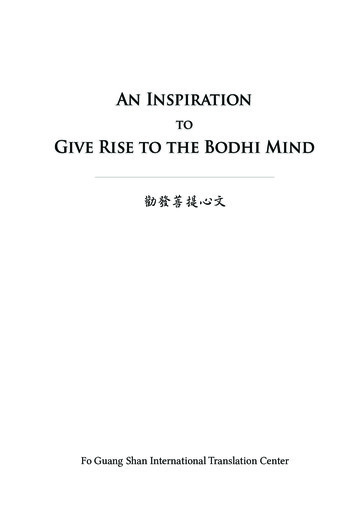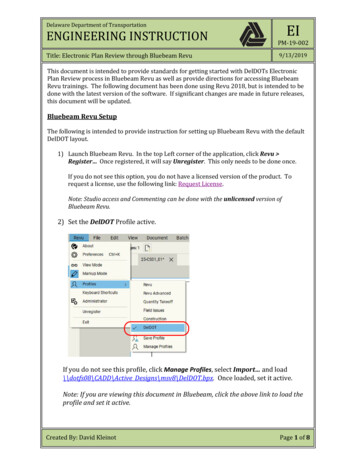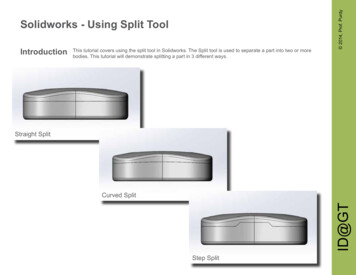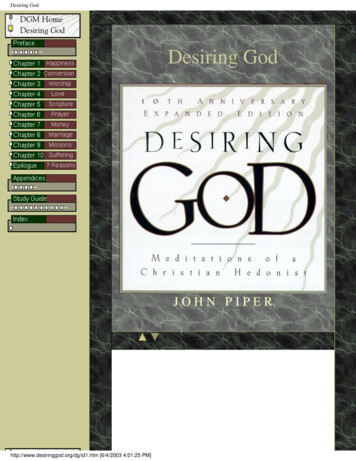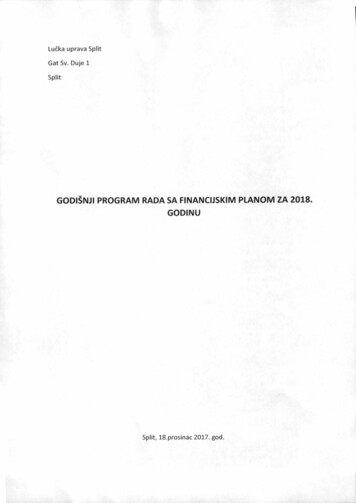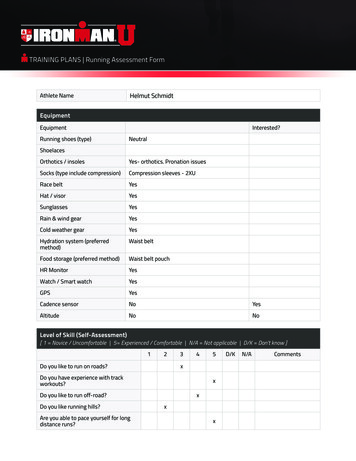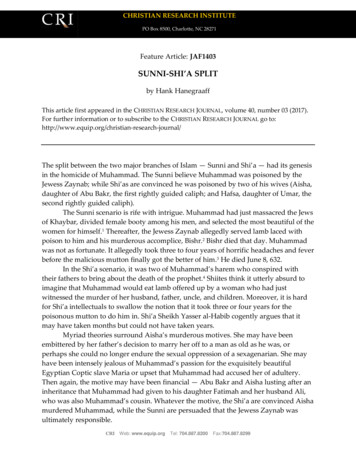
Transcription
CHRISTIAN RESEARCH INSTITUTEPO Box 8500, Charlotte, NC 28271Feature Article: JAF1403SUNNI-SHI’A SPLITby Hank HanegraaffThis article first appeared in the CHRISTIAN RESEARCH JOURNAL, volume 40, number 03 (2017).For further information or to subscribe to the CHRISTIAN RESEARCH JOURNAL go /The split between the two major branches of Islam — Sunni and Shi’a — had its genesisin the homicide of Muhammad. The Sunni believe Muhammad was poisoned by theJewess Zaynab; while Shi’as are convinced he was poisoned by two of his wives (Aisha,daughter of Abu Bakr, the first rightly guided caliph; and Hafsa, daughter of Umar, thesecond rightly guided caliph).The Sunni scenario is rife with intrigue. Muhammad had just massacred the Jewsof Khaybar, divided female booty among his men, and selected the most beautiful of thewomen for himself.1 Thereafter, the Jewess Zaynab allegedly served lamb laced withpoison to him and his murderous accomplice, Bishr.2 Bishr died that day. Muhammadwas not as fortunate. It allegedly took three to four years of horrific headaches and feverbefore the malicious mutton finally got the better of him.3 He died June 8, 632.In the Shi’a scenario, it was two of Muhammad’s harem who conspired withtheir fathers to bring about the death of the prophet.4 Shiites think it utterly absurd toimagine that Muhammad would eat lamb offered up by a woman who had justwitnessed the murder of her husband, father, uncle, and children. Moreover, it is hardfor Shi’a intellectuals to swallow the notion that it took three or four years for thepoisonous mutton to do him in. Shi’a Sheikh Yasser al-Habib cogently argues that itmay have taken months but could not have taken years.Myriad theories surround Aisha’s murderous motives. She may have beenembittered by her father’s decision to marry her off to a man as old as he was, orperhaps she could no longer endure the sexual oppression of a sexagenarian. She mayhave been intensely jealous of Muhammad’s passion for the exquisitely beautifulEgyptian Coptic slave Maria or upset that Muhammad had accused her of adultery.Then again, the motive may have been financial — Abu Bakr and Aisha lusting after aninheritance that Muhammad had given to his daughter Fatimah and her husband Ali,who was also Muhammad’s cousin. Whatever the motive, the Shi’a are convinced Aishamurdered Muhammad, while the Sunni are persuaded that the Jewess Zaynab wasultimately responsible.CRI Web: www.equip.orgTel: 704.887.8200Fax:704.887.8299
This is hugely significant in that immediately following the murder ofMuhammad, a great controversy arose over who should succeed him. Those loyal toAisha and Abu Bakr believed it should be the best representative of the Muslimcommunity. Those loyal to Muhammad’s daughter Fatima and her husband Ali werehell-bent on the notion that it should be a blood relative. In the end, much to the chagrinof Ali, the blood relative of Muhammad, Abu Bakr succeeded Muhammad as the firstrightly guided caliph of Islam.Abu Bakr would be dead two years later (634), and Umar, father of Hafsa —Aisha’s alleged coconspirator — would succeed him as second rightly guided caliph.Umar reigned a mere decade (634–644) and Uthman, who succeeded him, a meagerdozen years (644–656). Following Uthman’s murder by a group of Muslim malcontents,Ali, son-in-law of Muhammad, finally got his turn as the fourth rightly guided caliph ofIslam.5 Ali would reign a scant five years (656–661) before being assassinated on theway to the mosque. Thus concluded the era of the four rightly guided caliphs in what isfondly commemorated as Islam’s greatest golden age (632–661).In essence, then, each of the first three rightly guided caliphs was considered tobe the best representative of the way (Sunna) of Muhammad; while Ali, the fourthrightly guided caliph, was finally supported (Shi’a) as the blood relative of Muhammad.The split between Sunni and Shia morphed into an unbridgeable chasm with themartyrdom of Husayn (680) — son of Ali and grandson of Muhammad. Having had thetemerity to oppose what he believed to be the oppressive and religiously misguidedcaliphate of the Umayyads and asserting his preeminence as the blood relative of theprophet, Husayn and seventy-two family and friends were martyred by anoverwhelming show of Sunni military might.6From then till now, the beheading of Husayn and company continues to be apassion motif inflaming Shi’a fury toward the Sunni as well as paving their path towardparadise. Each year on the tenth day of Muharram, the first month of the Islamiccalendar, Shi’a the world over commemorate the beheading of Husayn through playsand processions and by pounding their bare backs in mournful tribute to the severedhead of their beloved imam. For every tear shed, it is said that a hundred sins areforgiven. Yet with every self-flagellation, the divide between Shi’a and Sunni deepens.Due to reverential awe for Ali and Husayn, Shi’a Islam regards the imams thatfollowed these iconic men to be infallible interpreters of hidden meanings embedded inthe text of the Qur’an. By contrast, in Sunni Islam, the imam is less like a pope and moreakin to a parish priest. The majority faction within the Shi’a sect are called Twelvers inthat they acknowledge twelve historical imams, the last of whom they believe went intoa state of hiddenness in the year 873; while another faction dubbed Seveners await thereturn of a seventh imam variously believed to be either Musa or his brother Ismail.Shi’a believe that when the Mahdi — either the twelfth or seventh imam —emerges from his hiddenness (occultation), he will uproot the religions of the world. Hewill destroy the Antichrist and establish sharia as the undisputed universal law ofhumanity.7 Sunnis have a very different perspective on the matter. In their view, there isan end-time Messianic Mahdi who, unlike the Shi’a Mahdi, is not presently inCRI Web: www.equip.orgTel: 704.887.82002Fax:704.887.8299
occultation. While this Mahdi figures prominently into Sunni eschatology, it is Jesuswho will return and usher in the longawaited messianic age.8 “Allah’s Apostle said,‘The Hour will not be established until the Son of Mary (i.e., Jesus) descends amongstyou as a just ruler. He will break the cross, kill the pigs, and abolish the Jizya tax.Money will be in abundance so that nobody will accept it (as charitable gifts).”9We should also note that while Sunni Islam has four schools of sharia — Hanafi,Hanbali, Maliki, and Shafii — Shi'a has only one, Jafari. Other differences include theSunnis’ belief that the Qur’an is eternal and uncreated, in contrast to the Shi’a belief thatthe Qur’an is temporal and created;10 Sunnis are more geared toward predestinarianism,while the Shi’a hold more closely to a freedom of the will perspective;11 and whileSunnis forbid pictures in mosques, Shi’a mosques are replete with pictures of holyplaces and holy people, most notably Ali, Husayn, and Muhammad.12In terms of numbers, of the one billion, six hundred million Muslims in theworld, Sunnis constitute the clear majority — in the vicinity of 80 to 90 percent. Thetencountries with the largest Muslim populations are by number Indonesia, India,Pakistan, Bangladesh, Nigeria, Egypt, Iran, Turkey, Algeria, and Morocco. Shi’a have amajority in only four countries: Iran, Azerbaijan (former Soviet Republic), Bahrain, andIraq.13 If there is a kernel of hope for reunification amongst Sunni and Shi’a, it is foundin the longing for the return of either Jesus or the Mahdi as a catalyst for bringing thewhole of humanity into Dar al-Islam (House of Islam).Despite the perpetual hatred between Sunni and Shi’a, they have remarkableunanimity when it comes to the main and the plain things of Islam. Both believe inMuhammad as God’s final revelator, the Qur’an as God’s final revelation, and Islam asGod’s final religion. Moreover, Sunnis and Shiites cling in unison to the five pillars ofIslam: Shahada — “There is no god but Allah, and Muhammad is the Messenger ofAllah” Salat — Prayer five times a day for Sunnis, three for Shia Zakat — Giving alms for the benefit of needy Muslims Sawm — Fasting during the month of Ramadan Hajj — Meccan pilgrimage, as ableHank Hanegraaff is president of the Christian Research Institute and host of the BibleAnswer Man daily broadcast. Hank has authored more than twenty books, including TheComplete Bible Answer Book — Collector’s Edition, Revised and Updated (Thomas Nelson,2016) and the forthcoming M-U-S-L-I-M: What You Need to Know about the World’s FastestGrowing Religion (Thomas Nelson, 2017), from which this article is excerpted.CRI Web: www.equip.orgTel: 704.887.82003Fax:704.887.8299
NOTES1.See Ibn Ishaq, The Life of Muhammad: A Translation of Ishaq’s S rat Ras l All h, trans. A.Guillaume (Oxford: Oxford University Press, 1955), 511ff.; Al-Waqidi, The Life of Muhammad:Al-W qid ’s Kit b al-Magh z , ed. Rizwi Faizer, trans. Rizwi Faizer, Amal Ismail, andAbdulKader Tayob (London: Routledge, 2011), 311ff.; The History of al-Tabari: The Victory of Islam,vol. 8, trans. Michael Fishbein (Albany, NY: SUNY Press, 1997), bari/Tabari Volume 08.pdf.2. See Ishaq, The Life of Muhammad, 516; The History of al-Tabari, 123–24.3. As noted by Muhammad’s favorite wife Aisha, then still in her teens, “The Prophet in hisailment in which he died, used to say, ‘O ‘Aisha! I still feel the pain caused by the food I ate atKhaibar, and at this time, I feel as if my aorta is being cut from that poison’” (Sahih al-Bukhari5:59:713 [see also 5:59:551], t.php; see also Sahih al-Bukhari 3:47:786; SahihMuslim 026:5430).4. I draw from Mohammad A. Khan, “Why Aisha Likely Poisoned Muhammad, Not a JewishWoman, Part 1,” Islam Watch, apoisonedmuhammad-not-jewish-woman-1.html; “Fadak,” Shia Pen,www.shiapen.com/comprehensive/fadak.html; Shaykh Yasser Al-Habib, “Scandal: Aisha killedthe Prophet Muhammad!!” YouTube series begins: www.youtube.com/watch?v HiMgW9yd7w.5. Fred M. Donner, Muhammad and the Believers: At the Origins of Islam (Cambridge: Belknap Press,2010), 156–57.6. See Donner, Muhammad and the Believers, 177ff.; Stephen Schwartz, The Two Faces of Islam: TheHouse of Sa’ud from Tradition to Terror (New York: Doubleday, 2002), 37–38.7. See Samuel Shahid, The Last Trumpet: A Comparative Study in Christian-Islamic Eschatology, chap. 6(n.c.: Xulon Press, 2005).8. David Cook of Rice University writes, “Jesus’ arrival will usher in a messianic age; he will kill theAntichrist and afterward convert the Christians to Islam. Traditions about this messianic periodare very confused: many hold that the alternative messianic figure (the Mahdi) will appearduring the previous period of apocalyptic wars with the Byzantines and even that the Mahdi willbe the one to emerge victorious. A sharp conflict exists between the Jesus and Mahdi traditions,signaling the intense discomfort of many Muslims with the Jesus scenario. Since Jesus is sorevered by the Christians, it was apparently dangerous to leave him alone in control of theMuslim messianic future. Thus in many traditions he is madesubordinate to the Mahdi, a purelyMuslim messianic figure, to whom is assigned the more traditional roles of conquest andsubjection of enemy countries.” (David Cook, Contemporary Muslim Apocalyptic Literature[Syracuse, NY: Syracuse University Press, 2005], 9.)9. Sahih al-Bukhari 3:43:656, 43-sbt.php.10. Cyril Glassé, “Koran,” in The New Encyclopedia of Islam, rev. ed. (Walnut Creek, CA: AltamiraPress, 2001, 2002), 268, at Google Books, books.google.com/books?id focLroxfrUC&lpg PA268&dq Uncreatedness%20of%20the%20Quran&pg PA268#v onepage&q Uncreatedness%20of%20the%20 Quran&f false.11. Cf. Jane Idleman Smith and Yvonne Yazbeck Haddad, The Islamic Understanding of Death andResurrection (Oxford: Oxford University Press, 2002), 11ff.; “The Issue of Predestination and FreeWill,” Al-Islam.org, hirazi/issuepredestination-and-free-will.12. See the Internet version of the exhibition, “Devotion in Pictures: Muslim Popular Iconography,”presented in Bryggens Museum in April 2000, WebCite,CRI Web: www.equip.orgTel: 704.887.82004Fax:704.887.8299
www.webcitation.org/63BsneOUJ?url votion04.html.13. See “The World’s Muslims: Unity and Diversity,” chap. 1, Religious Affiliation, Pew ResearchCenter, August 9, 2012, ty-anddiversity-1-religiousaffiliation/, and “The Future of the Global Muslim Population: Sunni andShia Muslims,” Pew Research Center, January 27, 2011, www. populationsunni-and-shia/.CRI Web: www.equip.orgTel: 704.887.82005Fax:704.887.8299
CRI Web: www.equip.org Tel: 704.887.8200 Fax:704.887.8299 CHRISTIAN RESEARCH INSTITUTE PO Box 8500, Charlotte, NC 28271 Feature Article: JAF1403 SUNNI-SHI'A SPLIT by Hank Hanegraaff This article first appeared in the CHRISTIAN RESEARCH JOURNAL, volume 40, number 03 (2017). For further information or to subscribe to the CHRISTIAN RESEARCH JOURNAL go to:

